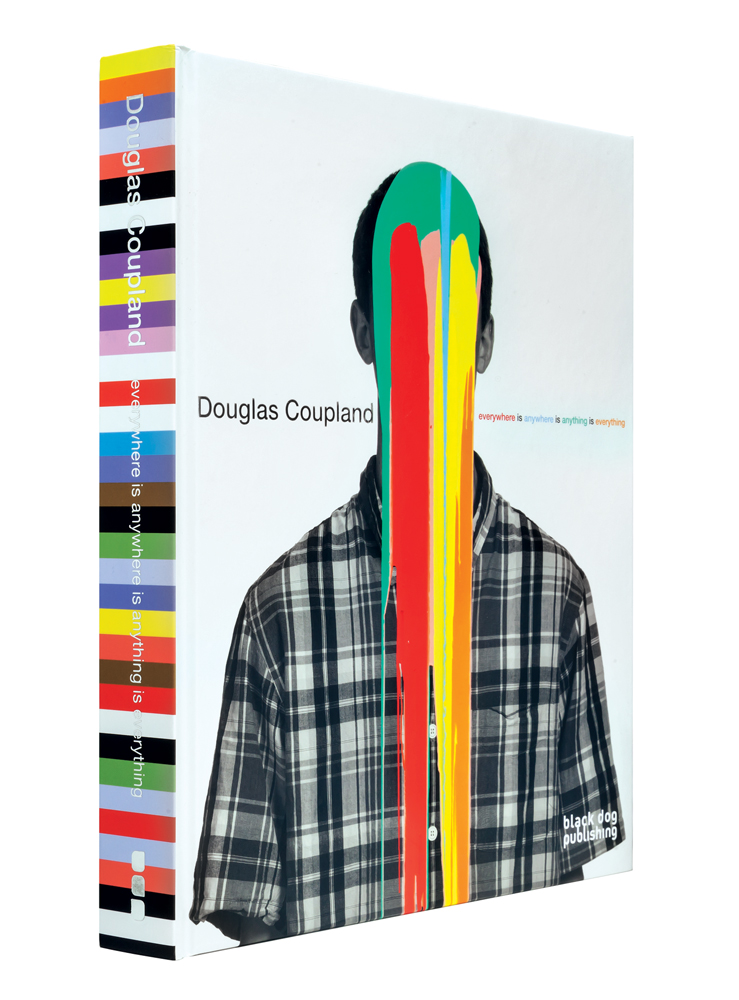The new year brings freshly released books. Here are some recent publications we recommend.
Douglas Coupland: Everywhere is Anywhere is Anything is Everything
Edited by Daina Augaitis, Black Dog Publishing, 296 pp, $34.95.
This glossy monograph—the first comprehensive overview of Douglas Coupland’s visual-art career—was co-produced by the Vancouver Art Gallery, where the maximalist artist had his first major survey exhibition in summer 2014. The exhibition, which includes more than 100 works from the early 2000s to the present day, makes its way to Toronto in January 2015. Smart and succinct essays by 16 cultural luminaries, including Hans Ulrich Obrist, Chuck Klosterman, Michael Stipe and William Gibson, provide useful context when sifting through the vast accumulation of objects that comprise Coupland’s collected works, and aid in translating the artist’s cacophonous vocabulary of slogans and logos into distilled musings on his idea of what constitutes the “21st-century condition.” The book’s six chapters correspond to the exhibition’s six sections. For those eager to explore deeper inside Coupland’s head, skip ahead to “The Brain,” where Bruce Grenville, senior curator at the VAG, reveals the organizing principles guiding the artist’s magpie collecting tendencies.
Curationism: How Curating Took Over the Art World and Everything Else
David Balzer, Coach House Books, 144 pp, $13.95.
The repositioning of art as a consumer culture is one of the hallmarks of the contemporary art world. This change has been a signal of the waning of more utopian conceptions of cultural production as they have been displaced by the skeptical ironies of Neo-Conceptualism and parallel academic and commercial infrastructures for art. Balzer’s book takes readers to the core of this generational paradigm shift. With its wary profile of curator-celebrity Hans Ulrich Obrist and its critical, structural overview of new norms in curatorial work practice, it constitutes essential reading on any curatorial-studies curriculum.
The Twenty First Century Art Book
Phaidon, 304 pp, $49.95.
This is the ultimate quick-study guide to contemporary art, presenting an insightful crash course on the most noteworthy works made since 2000 by more than 280 artists. Arranged alphabetically, the tome invites a smooth meandering through influential works ranging from performance to painting. A solid showing of Canadians, including the likes of Rebecca Belmore, David Altmejd, Brian Jungen and Jeff Wall, attests to our country’s presence on the global scene over the past 14 years.
Alibis: Sigmar Polke 1963–2010
Edited by Kathy Halbreich, the Museum of Modern Art, 320 pp, $75.00.
New Yorker art critic Peter Schjeldahl has called “Alibis” “the most dramatic museum show of the century to date.” While it sounds hyperbolic, he may well be right. In the Tate Modern version running this past fall, Polke seemed a major rediscovery, a rule-breaker without parallel. Whether in his Capitalist Realist works from the ’60s or the Negative Value triptych from Documenta 7, Polke pushed painting into uncharted territories. His last major works were stained-glass windows for a church in Zurich that managed enough ambiguity to seem more like portals to purgatory. The catalogue has it all.
Under the Sign of [sic]: Sturtevant’s Volte-Face
Bruce Hainley, Semiotext(e), 304 pp, $39.00.
Now is the time for Sturtevant. Elaine Sturtevant is a New York–based artist who, since the 1960s, has been copying the work of (mostly male) Conceptualists. Sturtevant’s parody of Conceptualism’s own parodic interventions presages digital culture, with its questioning of authenticity and identity. And it is written about with flair and intelligence by Artforum contributor Bruce Hainley, who makes the study his own artwork, bifurcating the first part (with different stories on verso and recto pages) and reintegrating it (barely) to finish. Odd, gleeful, essential.
33 Artists in 3 Acts
Sarah Thornton, W.W. Norton and Company, 352 pp, $31.00.
Sarah Thornton’s 2008 bestseller Seven Days in the Art World was an impressive feat of reportage, and her new book brings the same fresh savvy to the inner workings of the contemporary art world. Importantly, her book is an archive of the voices of some of the leading artists on today’s scene. In this, it redresses the market and curatorial sway that have been the foreground of the art world in the past decade. The book is about how artists speak and think, rendered by a writer with an ear for primary sources and territories.
Google, Volume 1
Edited by King Zog, Jean Boîte Éditions, 1,328 pp, $140.00.
This distinctive editioned artist’s book from London’s Felix Heyes and Ben West (collectively known as King Zog) reproduces the first image-search result shown by Google Images for every word in the Oxford English Pocket Dictionary. A smart project that provides a wry commentary on Google’s ubiquity and authority, it presents an idiosyncratic snapshot of the circulation of images and the diffusion of language in a digital era.
This article is based on the Readings section of the Winter 2015 issue of Canadian Art. To read more from this issue, visit its table of contents. To read the entire issue, pick up a copy on newsstands or the App Store until March 14.









